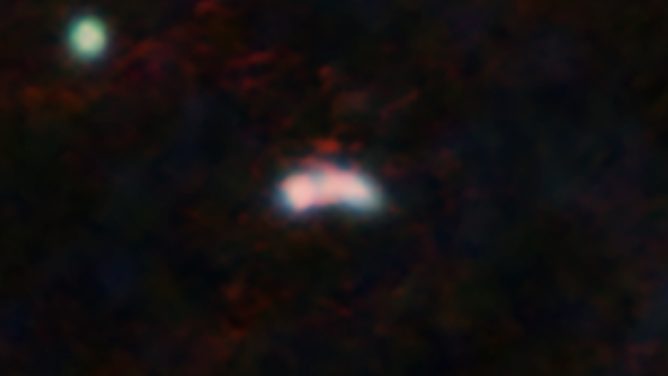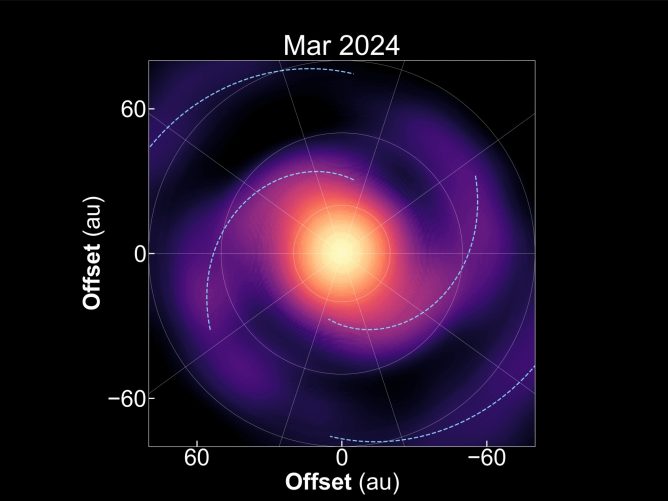2023.06.20
Observations of High-Mass Star Seeds Defy Models

Figure 1: An artist’s view on the internal structure of an infrared dark cloud revealed by ALMA. The raw material for star formation consists of gas and dust. Here, the densest regions are represented in white and lower densities in blue-ish colors. Some protostars just formed eject gas in outflows, represented by the pink color.
Credit: ALMA (ESO/NAOJ/NRAO), K. Morii et al.
High-mass stars play a crucial role in the creation of essential ingredients for life. These luminous entities possess immense energy, exerting a substantial influence on their surrounding environments. However, despite their significance, the process of high-mass star formation remains an area of uncertainty, primarily attributed to the scarcity and remoteness of regions where high-mass stars are born, in contrast to their low-mass counterparts.
Driven by the desire to unravel the mysteries surrounding the formation of energetic, brilliant high-mass stars, Kaho Morii, Patricio Sanhueza, and Fumitaka Nakamura led an international team that embarked on a mission to observe regions where such stars had yet to ignite. To accomplish this, acquiring sufficient spatial resolution capable of discerning the nascent stellar seeds, similar to those found in nearby low-mass star-forming regions, became imperative. Additionally, a statistical study was needed to determine the typical properties of these gas condensations. The team used ALMA which meets these requirements.
The team concentrated their efforts on 39 massive, cold, and dense clouds, which appeared as dark silhouettes in infrared observations, commonly referred to as infrared dark clouds (IRDCs). These clouds, believed to be the very birth sites of high-mass stars, displayed no discernible signs of ongoing star formation. ALMA observations at a wavelength of 1.3 mm allow the detection of stellar seeds, consisting of gas and dust, embedded in such clouds.
The researchers detected more than 800 stellar seeds, referred to as molecular cloud cores, from thirty-nine regions (as shown in Figure 2). This is the largest sample so far identified in clouds that have the potential to form high-mass stars. These cores represent the most promising sites for future high-mass star formation. This remarkable achievement was made possible through the employment of ALMA, which boasts high sensitivity, high-angular resolution, and efficient mapping capabilities.

Figure 2: Dust emission map for thirty-nine targets.
Credit: ALMA (ESO/NAOJ/NRAO), K. Morii et al.
Surprisingly, it was found that a staggering 99% of these stellar seeds lacked the necessary mass to give rise to high-mass stars if the same growth scenario as low-mass stars is assumed. In low-mass star formation, approximately 30-50% of the initial core mass is converted into stellar mass, while the remaining is expelled out mostly in molecular outflows. The study suggests that the cores found in the IRDCs must grow by accreting additional gas from their surroundings. These findings support a distinct star formation mechanism for high-mass stars, differing from what is conventionally believed for low-mass stars.
Furthermore, the team investigated the distribution of cores. In stellar clusters, high-mass stars are grouped, while low-mass stars are widely distributed. Assuming the high-mass cores the team identified evolved into high-mass stars, a different spatial distribution between high-mass and low-mass cores is expected to appear. However, this work revealed that the location of higher-mass cores exhibits no preference compared to the position of lower-mass cores. On the other hand, denser cores tend to be locally concentrated. This suggests that denser cores rather than more massive cores may be the progenitors of high-mass stars.
“We have shown with more certainty than previous studies that high-mass stars have a different growth scenario compared to low-mass stars. Also, we can infer that denser cores in clusters may grow up more efficiently by accumulating surrounding material. It seems that density is more important than the original mass for massive stars formation.” says Kaho Morii, a graduate student at the University of Tokyo.
Patricio Sanhueza, a Project Assistant Professor at the National Astronomical Observatory of Japan ALMA Project, explains the significance of this result for the future: “The extensive catalog of stellar seeds generated through this study serves as a vital cornerstone for enhancing our comprehension of high-mass star formation and refining existing models in this field.”
Paper Information
These observation results were published as Kaho Morii et al. “The ALMA Survey of 70μm Dark High-mass Clumps in Early Stages (ASHES). IX. Physical Properties and Spatial Distribution of Cores in IRDCs” in the Astrophysical Journal on June 20, 2023 (doi: 10.3847/1538-4357/acccea.).
This work is supported by a Grant-in-Aid from the Japan Society for the Promotion of Science (JP22J21529, JP22H01271, JP23H01221), World-leading Innovative Graduate Study Program (WINGS) of the University of Tokyo, DFG in the Collaborative Research Center SFB 881 (Project ID 138713538) “The Milky Way System” (subproject B1), and ANID BASAL project FB210003.
The Atacama Large Millimeter/submillimeter Array (ALMA), an international astronomy facility, is a partnership of the European Organisation for Astronomical Research in the Southern Hemisphere (ESO), the U.S. National Science Foundation (NSF) and the National Institutes of Natural Sciences (NINS) of Japan in cooperation with the Republic of Chile. ALMA is funded by ESO on behalf of its Member States, by NSF in cooperation with the National Research Council of Canada (NRC) and the National Science and Technology Council (NSTC) in Taiwan and by NINS in cooperation with the Academia Sinica (AS) in Taiwan and the Korea Astronomy and Space Science Institute (KASI).
ALMA construction and operations are led by ESO on behalf of its Member States; by the National Radio Astronomy Observatory (NRAO), managed by Associated Universities, Inc. (AUI), on behalf of North America; and by the National Astronomical Observatory of Japan (NAOJ) on behalf of East Asia. The Joint ALMA Observatory (JAO) provides the unified leadership and management of the construction, commissioning and operation of ALMA.









